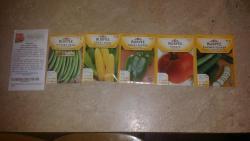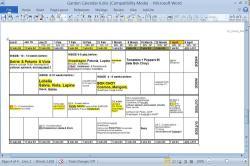By the way - I noticed that your vegetables were all warm-season crops. No lettuce or peas or snap peas or broccoli or Bok Choy?
>> How early do you start these seeds indoors to ensure their survival outdoors?
I agreed with Neal: "direct sow beans, corn, and squash". Starting them indoors might be very hard. If summer is just too short to direct-sow, consider sowing under a plastic hoop tunnel, and/or a floating row cover, to get 2-4 more weeks of warmth.
But I cross-posted with Woofie and she knows your climate, so listen to her instead of me.
http://garden.org/apps/calenda...
I agree with Jean: Dave's garden calendar will suggest times to start things indoors or outdoors, based on your ZIP code's average weather over the last 20-30 years.
Those will be good approximations, but some varieties and some micro-climates will always steer you a few weeks earlier or later ... only experimentation over a few seasons will tell you. Idaho ... mountains? Elevation makes a huge difference in planting time. Garden calendars like Dave's always choose sowing and planting dates based on the
average last frost date over the last 20-30 years. But all you care about is the ACTUAL last frost date that is going to happen THIS year ... for which you need a crystal ball. You might plan your dates in two waves: an optimistic wave that assumes no late frosts, and a pessimistic wave that won't give you any early veggies, but is very unlikely to be killed by unseasonable weather.
They always depend on this year's weather matching the average climate: an unusually late frost can kill plants or slow them down. An early spring means you "wasted" a few weeks waiting for the safe time. If you sow a few 2-3 weeks early, sow most on the calendar's date, and sow a few 2 weeks late, you'll have some crop even if the weather doesn't cooperate or your varieties happen to be "extra-early" or "late season" varieties.
I've heard that parts of Idaho have severe weather, including unsettled springs with cold snaps coming along any old time. And your seed packets are "Burpee". I think they are a mass-market, one-size-fits-all, national brand. IF you can find any seed vendor that specializes in varieties for your area, they will have varieties better suited to whatever your summers are like.
Once you find such local vendors, look over their websites and seed catalogs. They should mention varieties' unusual traits that are suited to local conditions - whatever they are. Like short summers, drying winds, cold snaps, drought, or whatever. Take note of the variety names that are particularly able to resist whatever your worst stresses are. Then look for those varieties all being sold by one vendor, so you can buy everything in one place next year. Or look at our plant database for that variety, see who owns it, and ask if they trade seeds.
I thought there might not be many Idaho seed vendors, but Googling "Idaho seed vendors" gave me a goodly list! I don't know if they're good, bad or clueless but here are some. You could check "The Green pages" to see if other ATP members recommend them. (But Dave doesn't have a space for NEGATIVE reviews, last time I looked.)
Once you pick a few local seed vendors and wonder which to trust most, you might ask in the PNW forum if anyone has tried those seed vendors, or who they DO buy from when shopping around for unfamiliar, locally-adapted varieties.
http://garden.org/forums/view/...
(this PDF has a long list of vendors in PDF form)
http://www.nrcs.usda.gov/Inter...
(once you get here, search this site for "seed vendors:)
http://www.nrcs.usda.gov/wps/p...
like so:
http://usdasearch.usda.gov/sea...
containi9ng:
Plant and Seed Vendors (MT-57) | NRCS
www.nrcs.usda.gov/wps/portal/nrcs/detail/mt/home/?cid=nrcs144p2_057745
Plant and Seed Vendors for Idaho, Montana, Nevada, Eastern Oregon, Utah, Eastern Washington, and Wyoming. A printer-friendly version of this ...
Seed Source Selection (MT-67) | NRCS Montana
www.nrcs.usda.gov/wps/portal/nrcs/detail/mt/home/?cid=nrcs144p2_057709
Seed Source Selection, Use of Certified Seed, and Appropriate Seed Release .... For sources of certified seed, reference Plant and Seed Vendors for ...
Meadow Brome (MT-95) | NRCS Montana
www.nrcs.usda.gov/wps/portal/nrcs/detail/mt/plantsanimals/?cid=stelprdb1192502
Seed stalks are from 24 to 48 inches tall and extend above the leaf mass in an .... and Seed Vendors for Idaho-Montana-Nevada-Eastern ...
More Information About Native Landscaping | NRCS Montana
www.nrcs.usda.gov/wps/portal/nrcs/detail/mt/water/resources/?cid=nrcs144p2_057457
... Landscape Association offsite link image; Plant and Seed Vendors for Idaho, Montana, Nevada, Eastern Oregon, Utah, Eastern Washington, and ...
Technical References - Plant Fact Sheets, Plant Guides and ...
www.nrcs.usda.gov/wps/portal/nrcs/detail/mt/home/?cid=nrcs144p2_047763
Note 14 Seed Production Standards for Conservation Plants (PDF; 190 KB) ... Note 33 Plant and Seed Vendors for Idaho, Montana, Nevada, Eastern ...
More Information About Rain Gardens | NRCS Montana
www.nrcs.usda.gov/wps/portal/nrcs/detail/mt/homeowner/?cid=nrcs144p2_057469
Plant and Seed Vendors for Idaho, Montana, Nevada, Eastern Oregon, Utah, Eastern Washington, and Wyoming · Montana NRCS - Information About ...

